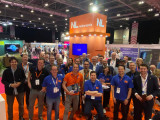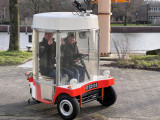MOVE24: Mobility Re-imagined London

Last week, I attended MOVE24: Mobility Re-imagined in London. On behalf of Amsterdam Smart City, I participated in a panel on developing customer-oriented transportation to reduce private car usage. Read on for my highlights from this event 👇
During the panel, it became clear that this can only be achieved if the alternatives are well-organized. Both governments and companies need to invest in high-quality alternatives for the long term and market them better. While the car industry invested approximately 4 billion euros in marketing last year, the alternatives lagged behind due to a lack of budget.
Providers of shared mobility, such as VOI and TIER, are eager to get started with this. They also pointed out that there is an unfair distribution of public space in favor of cars. “The game is rigged,” said Christina Moe Gjerde from VOI.
There was also a trade mission from Amsterdam led by Willem van Heijningen, organized by Amsterdam Trade & Innovate, Jorrit Saaltink, RvO, Lisa Haenitsch-Saxe, and the Dutch embassy with Tessel van Essen and Daphne Blokhuis. Els de Wit from the Ministry of Infrastructure and Water Management also joined. About 20 entrepreneurs were present in the fields of smart data, smart charging, cargo bikes, and Smart Mobility. It was great to see that the solutions are being provided by these talented people in our own country!
“What became clear to me in London was that the industry around smart and sustainable solutions is maturing. Ideas like the 15-minute city and the circular society are also maturing. However, there is still insufficient organizational capacity, perseverance, money, and awareness to make a real shift. A joint effort from governments, companies, knowledge institutions, and societal organizations is needed to bring about this change. And that is exactly the proposition of Amsterdam Smart City!”




